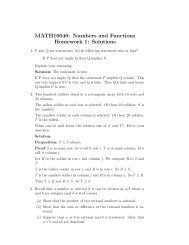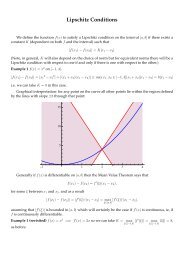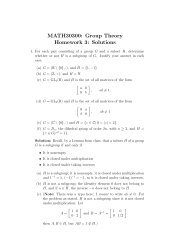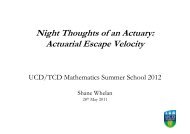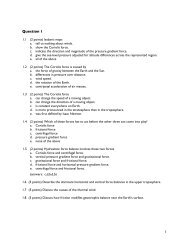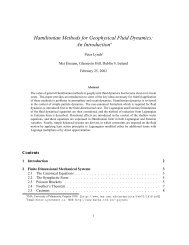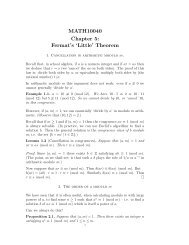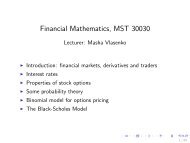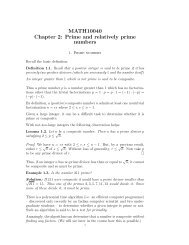new l<strong>in</strong>es <strong>of</strong> research.One popular <strong>the</strong>me <strong>in</strong> number <strong>the</strong>ory has been that <strong>of</strong> sums <strong>of</strong> squares.<strong>in</strong>tegers can be written <strong>in</strong> <strong>the</strong> formx 2 + y 2 ,Whatwhere x <strong>and</strong> y are <strong>in</strong>tegers, or <strong>in</strong> <strong>the</strong> formx 2 + y 2 + z 2 ,where x, y <strong>and</strong> z are <strong>in</strong>tegers, <strong>and</strong> so on. Bachet (who translated <strong>the</strong> Arithmetica <strong>of</strong>Diophantus <strong>in</strong>to Lat<strong>in</strong> <strong>in</strong> 1621, a translation much used by <strong>Fermat</strong>) conjectured thatevery <strong>in</strong>teger n is a sum <strong>of</strong> four squares,n = x 2 + y 2 + z 2 + w 2 ,where x, y, z <strong>and</strong> w are <strong>in</strong>tegers. This was eventually rigorously proved by Lagrange<strong>in</strong> 1770’s. <strong>Fermat</strong>, <strong>in</strong> a letter to Mersenne <strong>in</strong> 1640, asserted that any prime p satisfy<strong>in</strong>gp ≡ 1 mod 4 can be written asp = a 2 + b 2 ,for suitable <strong>in</strong>tegers a <strong>and</strong> b. If we assume that 0 < a < b, <strong>the</strong>n a <strong>and</strong> b are unique. Exactdetails <strong>of</strong> his pro<strong>of</strong> are not available but he claimed to use his method <strong>of</strong> <strong>in</strong>f<strong>in</strong>ite descent,which is a powerful method that may be applied to certa<strong>in</strong> Diophant<strong>in</strong>e equations. It is asort <strong>of</strong> <strong>in</strong>duction <strong>in</strong> reverse. He probably used <strong>the</strong> technique <strong>in</strong> his study <strong>of</strong> <strong>the</strong> so-called<strong>Fermat</strong> problems, such as show<strong>in</strong>g that <strong>the</strong>re are no solutions to <strong>the</strong> equationx 3 + y 3 = z 3 ,where x, y <strong>and</strong> z are all non-zero <strong>in</strong>tegers. He certa<strong>in</strong>ly showed that <strong>the</strong>re are no non-trivial<strong>in</strong>teger solutions to <strong>the</strong> equationx 4 + y 4 = z 4 ,us<strong>in</strong>g his method <strong>of</strong> <strong>in</strong>f<strong>in</strong>ite descent.His success <strong>in</strong> show<strong>in</strong>g <strong>the</strong> non-existence <strong>of</strong> non-trivial <strong>in</strong>tegral solutions to <strong>the</strong>seDiophant<strong>in</strong>e equations must have led <strong>Fermat</strong> to believe that <strong>the</strong> method <strong>of</strong> descent couldlikewise prove that <strong>the</strong>re are no non-zero <strong>in</strong>tegers x, y <strong>and</strong> z that satisfyx n + y n = z n ,6
whenever n is an <strong>in</strong>teger greater than 2. He certa<strong>in</strong>ly left a note <strong>in</strong> <strong>the</strong> marg<strong>in</strong> <strong>of</strong> his copy<strong>of</strong> <strong>the</strong> Arithmetica stat<strong>in</strong>g that he had found such a solution. This assertion achieved<strong>in</strong>ternational prom<strong>in</strong>ence with <strong>the</strong> publication <strong>of</strong> <strong>Fermat</strong>’s collected works <strong>in</strong> 1679, whichbrought <strong>Fermat</strong>’s claim out <strong>in</strong>to <strong>the</strong> open. Nobody was able to make <strong>the</strong> method <strong>of</strong> descentapply <strong>in</strong> <strong>the</strong> cases where n > 4, <strong>and</strong> we must presume that <strong>Fermat</strong> was wrong <strong>in</strong> his claim.In fact, attempts to verify <strong>the</strong> truth <strong>of</strong> <strong>Fermat</strong>’s Last Theorem (as <strong>the</strong> problem becameknown) led to <strong>the</strong> development <strong>of</strong> a vast generalization <strong>of</strong> arithmetic known as algebraicnumber <strong>the</strong>ory, <strong>in</strong> which <strong>the</strong> <strong>the</strong>ory <strong>of</strong> primes <strong>and</strong> unique factorization is carried over tocerta<strong>in</strong> special types <strong>of</strong> complex number. Even this was not enough to prove <strong>Fermat</strong>’sLast Theorem <strong>in</strong> general, as <strong>the</strong> complete pro<strong>of</strong> by Andrew Wiles <strong>in</strong> 1995 used techniques<strong>of</strong> algebraic geometry <strong>and</strong> modular form <strong>the</strong>ory.<strong>Fermat</strong> considered fur<strong>the</strong>r problems concern<strong>in</strong>g primes.that every prime p satisfy<strong>in</strong>g p ≡ 1 mod 3 is expressible asFor example, he claimedp = a 2 + 3b 2for suitable <strong>in</strong>tegers a <strong>and</strong> b (letter to Pascal, 1654). All <strong>of</strong> <strong>Fermat</strong>’s claims are true,<strong>and</strong> he may well have proved <strong>the</strong>m. However, def<strong>in</strong>itive pro<strong>of</strong>s first appeared with Euler,<strong>and</strong> Gauss provided <strong>the</strong> most satisfactory approach to problems <strong>of</strong> <strong>the</strong> k<strong>in</strong>d considered by<strong>Fermat</strong>.We will now discuss some <strong>of</strong> <strong>Fermat</strong>’s work relat<strong>in</strong>g to primes. The Greeks had<strong>in</strong>vestigated properties <strong>of</strong> <strong>in</strong>tegers <strong>and</strong> Euclid’s Elements <strong>in</strong>cludes an account <strong>of</strong> what<strong>the</strong>y had discovered. Greek ma<strong>the</strong>maticians had a particular <strong>in</strong>terest <strong>in</strong> perfect numbers.An <strong>in</strong>teger n > 1 is said to be perfect if <strong>the</strong> sum <strong>of</strong> all its positive <strong>in</strong>teger divisors, <strong>in</strong>clud<strong>in</strong>g1 but exclud<strong>in</strong>g n itself, equals n. Thus, for example, 6 is perfect as its divisors less than6 are 1, 2 <strong>and</strong> 3 <strong>and</strong>1 + 2 + 3 = 6.Similarly, 28 is perfect, as its divisors are 1, 2, 4, 7 <strong>and</strong> 14, whose sum is 28.A means <strong>of</strong> produc<strong>in</strong>g even perfect numbers is described <strong>in</strong> Euclid’s Elements <strong>in</strong> <strong>the</strong>follow<strong>in</strong>g way. Suppose that for some positive <strong>in</strong>teger m, 2 m − 1 is a prime. Then <strong>the</strong><strong>in</strong>teger 2 m−1 (2 m − 1) is perfect. For, if we set 2 m − 1 = p, where p is a prime, it is easyto see that <strong>the</strong> divisors <strong>of</strong> n = 2 m−1 p are1, 2, 2 2 , · · · , 2 m−1 , p, 2p, · · · , 2 m−2 p.7




